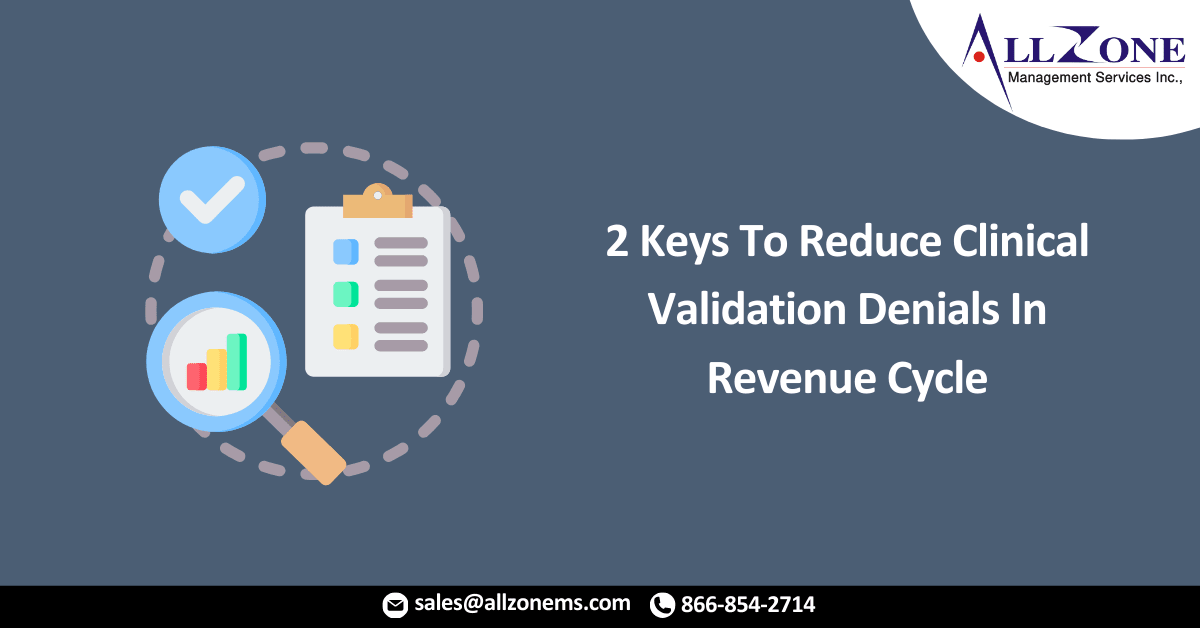KEY TAKEAWAYS
- Denials rose to 11% of all claims last year, up nearly 8% from 2021.
- Revenue cycle leaders should place their focus on clinical validation denials to help ease the overall denials burden.
- A key defensive strategy for preventing denials is provider education.
- Revenue cycle leaders need to understand that clinical validation denials are also happening outside of the claims process and after payment.
Denials management has become a major area of concentration for revenue cycle leaders.
In fact, denials rose to 11% of all claims last year, up nearly 8% from 2021. That 11% rate translates into 110,000 unpaid claims for an average-sized health system, according to the report.
While prior-authorization denials were at the heart of the cost increase in that study, there’s another area revenue cycle leaders should place their focus to help ease the denials burden: clinical validation denials.
Clinical validity denials occur when there is a lack of clinical evidence in the patient chart to support a billed diagnosis. Claims may be denied, for example, if they lack clinical criteria necessary to support a diagnosis, contain inconsistencies, or do not meet payer-specific diagnostic criteria.
In most revenue cycles, the CDI staff is responsible for reviewing documentation to ensure that it supports reported diagnoses and for collaborating with staff to update documentation that is insufficient to support medical necessity.
Because your CDI teams have such a heavy hand in documentation review, they make it the perfect place to start when shoring up clinical validation denials.
A key defensive strategy for preventing denials is provider education. This can involve bringing data on the financial impact of documentation inconsistencies to providers and explaining how they can be prevented.
For example, a healthcare company tracked and analyzed claims for acute respiratory failure that were denied due to a lack of explicit documentation of symptoms to support medical necessity. “If the patient has acute respiratory failure, you can’t only use phrases such as ‘patient resting comfortably.’ The patient may be resting comfortably for a period, but this doesn’t support a diagnosis of respiratory failure.”
In this instance, the CDI staffs were able to effectively reduced denial rates for respiratory failure and other similar diagnoses by educating providers on the effective use of key clinical terminology to clearly explain the patient’s current health status.
Clinicians want to document better and don’t want to get a query. They may also have their own ideas for preventing documentation inconsistencies such as incorporating prompts into their EMR [electronic medical record].
Making sure your middle revenue cycle leaders collaborate and continue to be educated on regulatory changes will help to improve on these denials before they happen.
But what if these denials still happen?
It’s essential for revenue cycle leaders to understand that these denials are even happening outside of the claims process and after payment, usually through MS-DRG downgrades.
These financial take backs are often occurring under the radar because the business office staff doesn’t know about the denial because the account is at a $0 balance.
Collaboration between your CDI teams, utilization review, and the business office staff is essential to understand the current state of clinical validity denials at your facility.
Revenue cycle leaders can’t assume that appealing a denial or MS-DRG downgrade will result in the payer responding back to you.
“In working through an internal, home-grown tracking tool for clinical validity denials, we identified a black hole with cases in which we never heard back from the payer. In following up, we often heard, ‘We didn’t get the appeal, and now you are past your timeframe to appeal,’” an expert said.
“We knew this was incorrect because we document fax confirmations on all our appeals. The follow up work for these denials needs to be discussed in your facility to determine who is best to perform a follow-up or these cases will often go through as denied, and the payer will recoup the difference of the MS-DRG on another remit,” the expert warned.
Tracking the volume of these denials is essential to understanding trends specific to certain diagnoses, MS-DRGs, and payers. Tracking these types of denials supports the program of work by showing that without dedicated staff managing appeals, there can be a significant loss in revenue for a health system
For More Information: preventing and defending 2 keys reducing clinical validation denials revenue cycle

